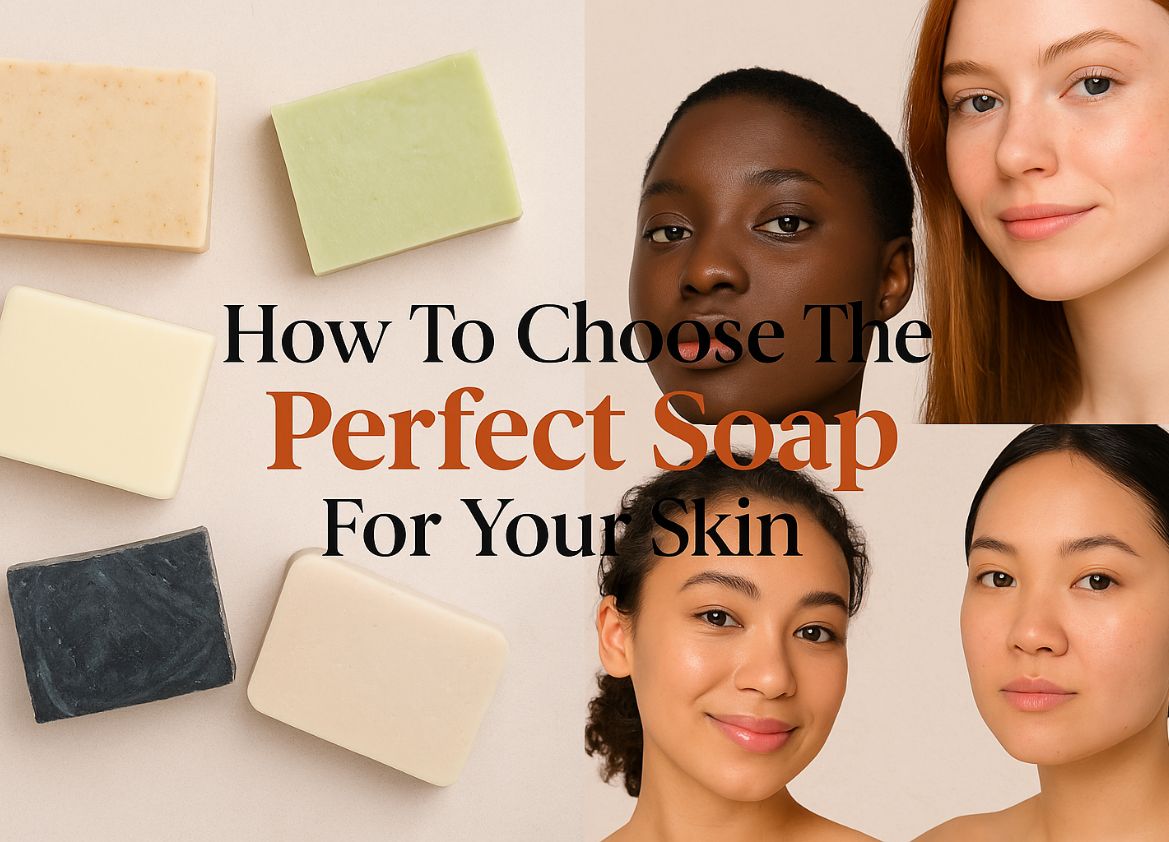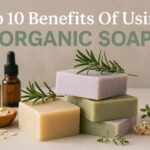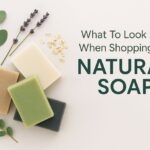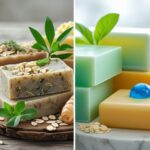Are you standing in the skincare aisle feeling completely overwhelmed by the endless soap options? Trust me, I’ve been there. With hundreds of colorful bars and bottles promising everything from “deep cleansing” to “moisturizing benefits,” finding the perfect soap for your unique skin can feel like searching for a needle in a haystack.
But here’s the truth: choosing the right soap isn’t just about smelling nice or following trends. It’s about understanding what your skin actually needs. The wrong soap can strip your skin’s natural oils, trigger breakouts, cause irritation, or leave your face feeling like the Sahara Desert.
Over the years with even more soap innovations hitting the market, making the right choice has never been more important or more confusing. But don’t worry! I’ve helped thousands of clients transform their skin by simply switching to the perfect soap, and today I’m going to walk you through exactly how to choose the perfect soap for your skin type.
Understanding Your Skin Type
How to Identify Your Skin Type
Before you even think about which soap to buy, you need to know what you’re working with. Your skin type is like your personal skincare ID card—it tells you what your skin needs and what it doesn’t.
Here’s a quick way to determine your skin type at home:
- The Bare-Face Test: Wash your face with a gentle cleanser, pat dry, and don’t apply any products.
- Wait 30 minutes: Let your skin do its natural thing.
- Check your T-zone: Look at your forehead, nose, and chin.
- Assess how your skin feels: Tight? Oily? Comfortable?
Based on your observations, you’ll fall into one of these categories:
- Normal skin: Feels comfortable, not oily or dry, with small pores and good elasticity
- Dry skin: Feels tight, might have flaky patches, fine lines are more visible
- Oily skin: Shiny appearance, especially in the T-zone, with enlarged pores
- Combination skin: Oily in the T-zone but normal or dry on the cheeks
- Sensitive skin: Easily irritated, might become red or itchy with new products
💡 Pro tip: Your skin type can change with seasons, hormones, and age. Reassess every few months to make sure you’re still using the right products.
Why Skin Type Matters When Choosing Soap
Using the wrong soap for your skin type is like putting diesel in a gasoline car—it’s just not going to work right. Here’s what happens when you mismatch:
| Skin Type | Wrong Soap Effects | Right Soap Benefits |
|---|---|---|
| Dry | Further drying, flaking, irritation | Hydration, comfort, barrier repair |
| Oily | Overproduction of oil, clogged pores | Balanced oil production, fewer breakouts |
| Combination | Dry patches + oily zones get worse | Balanced moisture across all areas |
| Sensitive | Redness, irritation, burning | Calm, comfortable skin with reduced reactivity |
| Normal | May disrupt natural balance | Maintains healthy skin condition |
“I spent years using harsh, foaming cleansers because I thought my oily skin needed to be ‘squeaky clean,'” shares one of my clients. “Turns out I was stripping my skin so badly that it was overproducing oil to compensate. Switching to a gentler soap actually reduced my oiliness by 80%!”
Types of Soap
Natural vs. Conventional Soap
The soap aisle is basically divided into two main camps: natural and conventional. Let’s break down the differences:
Conventional Soaps:
- Mass-produced using synthetic ingredients
- Often contain sulfates for that satisfying foam
- Usually cheaper and widely available
- May include artificial colors and fragrances
- Typically have a longer shelf life
Natural Soaps:
- Made with plant-based oils and butters
- Often retain natural glycerin (a humectant that draws moisture to skin)
- Usually handcrafted in smaller batches
- Minimal preservatives
- May use essential oils instead of artificial fragrances
But here’s where many people get confused: natural doesn’t automatically mean better for everyone. If you have sensitive skin that reacts to essential oils, a fragrance-free conventional soap might actually be less irritating.
Specialty Soaps
Beyond the natural/conventional divide, there are specialty soaps designed for specific skin needs:
For Dry Skin:
- Moisturizing bars: Packed with shea butter, cocoa butter, and oils
- Cream cleansers: Less foaming, more hydrating
- Cold-processed soaps: Retain natural glycerin
For Oily/Acne-Prone Skin:
- Clarifying bars: With ingredients like tea tree oil, charcoal, or clay
- Salicylic acid cleansers: Help unclog pores
- Antibacterial formulas: Combat acne-causing bacteria
For Sensitive Skin:
- Hypoallergenic options: Free from common irritants
- Fragrance-free formulas: Avoid potential allergens
- Calming ingredients: Like oatmeal, aloe, or chamomile
For Aging Skin:
- Antioxidant-rich soaps: With vitamin E, green tea, etc.
- Gentle exfoliating bars: With fine natural exfoliants
- Hydrating formulas: To combat natural moisture loss
Key Ingredients to Look For
The back of a soap package might look like a chemistry test, but certain ingredients are worth hunting for depending on your skin’s needs:
Moisturizing Heroes
If your skin is dry or dehydrated, these ingredients are your best friends:
- Glycerin: A humectant that attracts moisture to your skin
- Shea butter: Rich in fatty acids that nourish and protect
- Coconut oil: Creates a light barrier to lock in moisture
- Hyaluronic acid: Holds up to 1000x its weight in water
- Aloe vera: Provides lightweight hydration
Soothing Agents
For sensitive or irritated skin, look for these calming ingredients:
- Chamomile: Anti-inflammatory properties reduce redness
- Oatmeal: Creates a protective, soothing layer
- Calendula: Healing and gentle
- Aloe vera: Cooling and calming (yes, it’s multi-purpose!)
- Green tea: Antioxidant protection and soothing properties
Balancing Ingredients
For oily or acne-prone skin, these ingredients help keep things in check:
- Tea tree oil: Natural antibacterial properties
- Activated charcoal: Absorbs excess oil and impurities
- Clay: Draws out oil and toxins
- Salicylic acid: Unclogs pores and exfoliates
- Witch hazel: Natural astringent that tightens pores
🔍 Ingredient spotlight: Glycerin is one of the most underrated skincare ingredients. It’s naturally produced during the soap-making process, but many commercial manufacturers remove it to sell separately (for more profit). Soaps that retain their natural glycerin are generally more moisturizing.
Ingredients to Avoid
Just as important as what to look for is what to avoid. These ingredients can cause more harm than good:
Harsh Detergents
- Sodium Lauryl Sulfate (SLS) and Sodium Laureth Sulfate (SLES): Create that satisfying foam but strip natural oils
- Ammonium Lauryl Sulfate: Another aggressive cleanser
- Diethanolamine (DEA): Can be drying and irritating
Potential Irritants
- Artificial fragrances: Listed as “fragrance” or “parfum” – a common allergen
- Synthetic colors: Often listed as FD&C or D&C followed by a color and number
- Parabens: Preservatives (methylparaben, propylparaben, etc.) linked to hormone disruption
- Formaldehyde-releasing preservatives: Like quaternium-15, DMDM hydantoin
Particularly Problematic for Specific Skin Types
| Skin Type | Ingredients to Avoid |
|---|---|
| Dry | Alcohol, high-foaming detergents, menthol |
| Sensitive | Fragrances, essential oils (for some), exfoliating acids |
| Oily | Coconut oil (can be comedogenic), heavy butters |
| Acne-prone | Cocoa butter, lanolin, mineral oil |
| Aging | Harsh alcohols, strong detergents |
“The moment I stopped using soaps with sulfates, my eczema flare-ups decreased by 90%,” reports another client. “I had no idea my ‘clean’ feeling was actually skin damage in disguise.”
How to Test a Soap Before Buying
Don’t commit to a full-size product without testing it first. Here’s how to safely try a new soap:
The Patch Test Method
- Get a sample: Many brands offer sample sizes or testers
- Choose your spot: Inside of your wrist or behind your ear
- Apply a small amount: Lather a pea-sized amount and apply to the area
- Wait 24-48 hours: Monitor for any adverse reactions
- Check for reactions: Redness, itching, burning, or bumps are all warning signs
Reading Your Skin’s Response
After using a new soap for the first time, pay attention to how your skin feels:
- Does it feel tight or dry? That’s a sign the soap is too harsh
- Is it comfortable and soft? Good sign!
- Any redness or irritation? Stop using immediately
- New breakouts within 48 hours? Likely a reaction, not purging
⚠️ Important note: Some reactions are immediate, but others can develop after repeated exposure. If you notice gradual changes in your skin after using a new soap, it might be time to reconsider.
Soap Selection Tips for Specific Skin Concerns
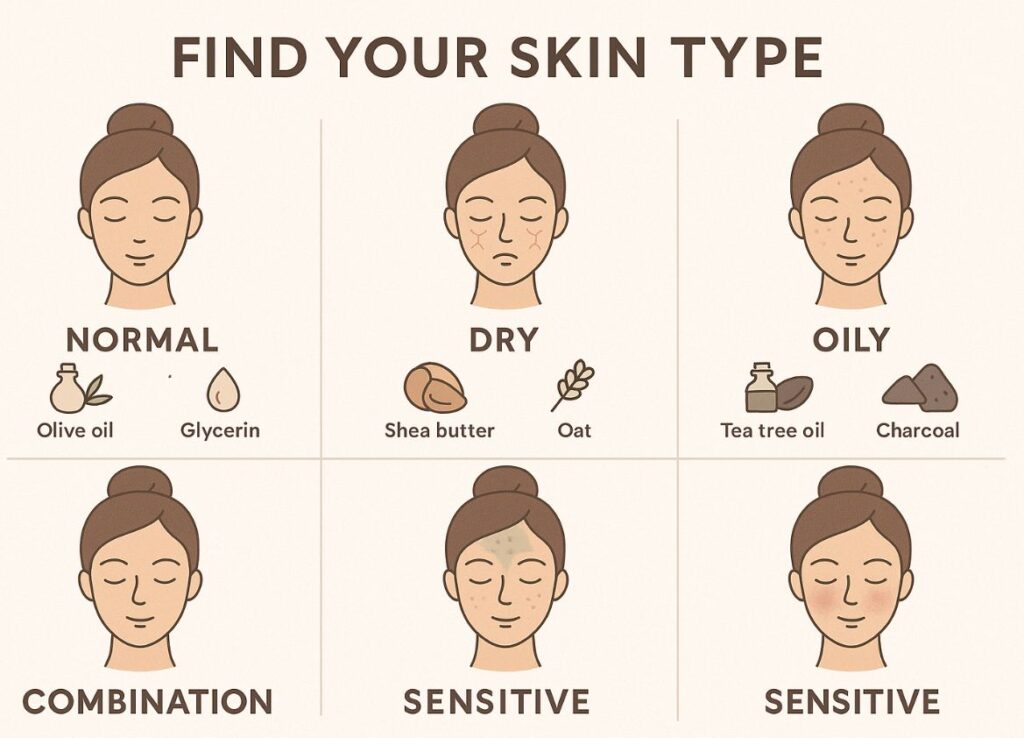
For Acne-Prone Skin
Acne isn’t just a teenage problem many adults struggle with it too. When choosing a soap for acne-prone skin:
- Look for non-comedogenic formulas that won’t clog pores
- Ingredients like salicylic acid and benzoyl peroxide can help (but don’t use both at once)
- Tea tree oil offers natural antibacterial benefits
- Avoid heavy oils like coconut or cocoa butter
- Don’t over-cleanse twice daily is plenty
For Dry or Flaky Skin
Dry skin needs extra TLC, especially during winter months:
- Choose cream-based cleansers or moisturizing bars
- Look for added oils and butters
- Avoid anything that foams vigorously
- Consider oil cleansing methods
- Always follow with moisturizer while skin is still damp
For Sensitive or Allergy-Prone Skin
Sensitive skin requires a cautious approach:
- Fragrance-free is different from “unscented” (which may use masking fragrances)
- Minimal ingredients mean fewer potential irritants
- Patch test everything, even “hypoallergenic” products
- Consider cold-processed soaps which tend to be gentler
- pH-balanced formulas (around 5.5) maintain your skin’s acid mantle
For Aging Skin
As skin matures, its needs change:
- Look for antioxidant-rich formulas with vitamins C and E
- Gentle exfoliation helps cell turnover (but not daily)
- Hydrating ingredients combat natural moisture loss
- Ceramides help strengthen the skin barrier
- Avoid harsh, stripping cleansers that emphasize fine lines
Common Myths About Soap and Skin
Let’s bust some persistent soap myths that might be affecting your skin choices:
Myth #1: “All natural soaps are always better for your skin”
Reality: Natural isn’t automatically better. Some natural ingredients like essential oils can be highly irritating for sensitive skin. What matters most is finding ingredients that work for your specific skin type.
Myth #2: “The more a soap foams, the better it cleans”
Reality: That satisfying foam often comes from harsh sulfates that strip your skin. Many effective, gentle cleansers produce minimal lather but clean just as well.
Myth #3: “Antibacterial soap is best for acne-prone skin”
Reality: Regular soap is just as effective at removing the bacteria that contributes to acne. Overuse of antibacterial ingredients can disrupt your skin’s natural microbiome and potentially contribute to resistant bacteria.
Myth #4: “You need different soaps for face and body”
Reality: While this is often true because facial skin tends to be more sensitive, some gentle formulations work well for both. The key is finding a pH-balanced, non-stripping formula.
Myth #5: “Moisturizing soaps make oily skin worse”
Reality: Stripping oils with harsh soaps actually triggers more oil production. A balanced, moisturizing cleanser can help regulate sebum production over time.
Soap Usage Tips for Maximum Benefits
Even the perfect soap won’t work well if you’re using it incorrectly:
Temperature Matters
- Use lukewarm water hot water strips natural oils
- Cold water doesn’t effectively remove oil-based impurities
- Finish with a cool rinse to help close pores
Technique Tips
- Lather in your hands first, not directly on your face
- Massage gently in circular motions no need to scrub
- Pay extra attention to your T-zone and hairline
- Rinse thoroughly soap residue can cause irritation
Frequency Guidelines
- Normal/combination skin: Twice daily (morning and night)
- Dry skin: Once daily, preferably at night
- Oily skin: Twice daily, with a gentle formula
- Sensitive skin: Once daily, with extra-gentle products
💡 Pro tip: If your skin feels tight after cleansing, your soap is too harsh even if you don’t have visibly dry skin.
Seasonal Soap Adjustments
Your skin’s needs change with the seasons, and your soap should too:
Winter Soap Strategy
Cold weather and indoor heating create a double whammy of dryness:
- Switch to more moisturizing formulas
- Cleanse less frequently if possible
- Look for added humectants like honey or glycerin
Summer Soap Adjustments
Heat, humidity, and increased oil production call for different approaches:
- Consider a slightly more clarifying formula
- You might need to cleanse more often (especially after sweating)
- Look for lightweight hydration rather than heavy oils
The Interactive Soap Selector
Use this interactive tool to find your perfect soap match:
Find Your Perfect Soap Match
Your Ideal Soap Type:
Look for these ingredients:
Conclusion
Choosing the perfect soap for your skin doesn’t have to be complicated. By understanding your skin type, knowing which ingredients to look for (and which to avoid), and being willing to experiment a little, you can find the ideal soap that leaves your skin clean, balanced, and healthy.
Remember these key points:
- Start with your skin type – This is the foundation of your soap selection journey
- Read ingredients, not marketing claims – What’s in the soap matters more than what’s on the package
- Patch test new products – Your skin is unique, and what works for others might not work for you
- Adjust with the seasons – Your skin’s needs change throughout the year
- Listen to your skin – If it feels tight, irritated, or breaks out, your soap might be the culprit
Finding your perfect soap might take some trial and error, but the reward healthy, glowing skin is absolutely worth it. Your skin is with you for life, so giving it the care it deserves with the right soap is one of the best investments you can make.
Ready to transform your skincare routine? Start by evaluating your current soap against what you’ve learned today, and don’t be afraid to make a change if needed. Your skin will thank you!
Frequently Asked Questions
Can soap cause acne?
Yes, the wrong soap can definitely cause acne. Soaps that are too harsh can strip your skin’s natural oils, prompting it to overproduce sebum as compensation—leading to clogged pores and breakouts. Additionally, some ingredients like coconut oil or cocoa butter can be comedogenic (pore-clogging) for certain skin types.
Is natural soap better for sensitive skin?
Not necessarily. While natural soaps avoid many synthetic chemicals that can irritate sensitive skin, they often contain essential oils which can be major irritants for many people with sensitive skin. The best soap for sensitive skin is one with minimal ingredients and no fragrance, whether natural or conventional.
How often should I change my soap?
If your current soap works well for your skin, there’s no need to change it regularly. However, you might need to switch soaps when: your skin type changes (due to age, hormones, etc.), the seasons change dramatically, you move to a different climate, or you develop a new skin concern.
Can I use the same soap for face and body?
While it’s possible, it’s not ideal for most people. Facial skin is generally more sensitive and has different needs than body skin. Body soaps tend to be more stripping and have higher pH levels than what’s optimal for facial skin. However, if you have a gentle, pH-balanced cleanser, it might work well for both.
How can I tell if my soap is too harsh?
If your skin feels tight, dry, or “squeaky clean” after washing, your soap is likely too harsh. Other signs include increased redness, flakiness, irritation, or a sudden increase in oil production. Your skin should feel comfortable and soft after cleansing, not tight or dry.

